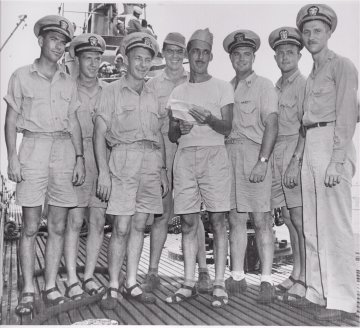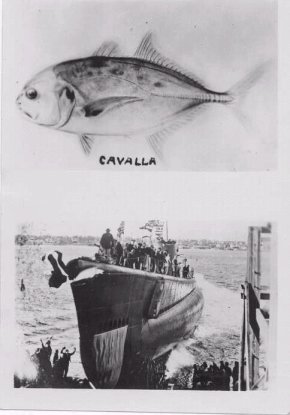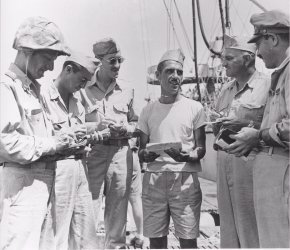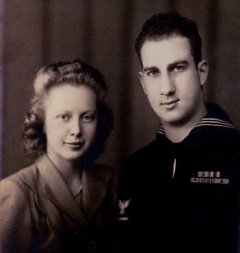The next day (26 November) Quartermaster 2nd class Pete Ureta's appendix ruptured. I recall that the pharmacist's mate wanted to put an ice bag on him--but no ice bag could be found on board. So a machinist's mate took two sheets of rubber and clamped the sides together for an improvised ice bag. They didn't want to operate, but they also didn't want to terminate the patrol early. (After the operation Ureta lay in his bunk until the end of the patrol--nearly seven weeks.) |
One of the crew made a big issue out of his Zippo lighter, claiming that it would light in a tornado--in a hurricane--anywhere. The crew got sick and tired of hearing about this lighter. One time he accidentally dropped it on deck, under the wooden planking. The Cavalla was soon thereafter approached by an enemy plane and forced to dive. Upon surfacing, 2 men went out to check the hull for damage. They found no damage, but they did find the lighter. They brought it up on deck and tried it--and behold, it worked! The boasts were even worse after that. Henry Albertine, Radioman 3rd Class, slept without benefit of any clothing whatever. His bunk was next to mine. When the Exec came in and saw him asleep in this fashion, he ordered him to put on shorts. Albertine protested, "But I've been sleeping this way all my life." This objection carried no weight with the Exec, and Albertine was compelled to sleep in a less revealing manner. My battle station for "Battle Surface" was gunner with the 20mm. gun, the same as my battle station on the Wilson. I was promoted from Seaman 1st class to Torpedoman 3rd class on 1 July 1944. Australia: I remember staying at the King Edward Hotel in Perth. Since all outgoing mail was read by officers for possible breaches of security, I tried to outwit the censor by writing to my wife, "I can't tell you where we are, but there are a heck of a lot of kangaroos here." On one occasion Torpedoman Charles "88" Keyes and I went to a restaurant in Perth where they were offered "styke" and "eyggs." "What in the world are 'styke' and 'eyggs?' " I wondered. After they repeated it a few times, I finally got it: steak and eggs with an Aussie accent. A big bottle of Aussie beer was 10˘. One day a crew member brought a baby kangaroo aboard as a pet. When Captain Kossler found out, he asked the sailor, "Do you know how long we'll be on patrol?" Sailor: "About 60 days." Kossler: "And do you know how big that kangaroo will be in 60 days? It won't fit through the hatch!" And the Captain ordered him to take the kangaroo off the boat, over his protestations of "But Captain, that's my pet!" |
James Rankin remembered this story about Joe Bellinghiere on an occasion when he was serving as lookout. "When we sighted a plane or made an enemy contact, the command was "CLEAR THE BRIDGE!" This brought three lookouts, the Junior Officer of the Deck (often an enlisted man) and the Officer of the Deck down through the conning tower hatch in what can best be described as a 'free-fall' maneuver. No-one climbed down the ladders. Hands on the siderails helped slow down the descent and toes rat-a-tat-ed on the rungs. One day Joe managed to get his feet through the rungs of the ladder about three steps up from the deck, landing his back on a railing. This left him horizontal. Alas, he was the first man down. Each succeeding lookout, J.O.O.D. and O.O.D. landed directly on Joe's midship portion. With each landing, Joe's comments were merely very large and loud grunts. Fortunately, he was in pretty good condition and suffered no physical harm. The ridiculousness of the action had everyone laughing until we realized we had exceeded our ordered depth and the laughter died as we came back to our senses." At the termination of Cavalla's fourth patrol (29 March 1945, Subic Bay, Philippines), Captain Kossler, in keeping with the standard procedure of transferring about one-fourth of the crew to the squadron and new construction, asked me if I wanted to be transferred. I thought "Why not?" Kossler told me that since I had been on the Cavalla since commissioning, he would advance me to Torpedoman 2nd Class. So I was thus transferred to Submarine Division 221, Subic Bay, where I spent the next four months.
I soon received orders to
report for duty on another submarine (either the Bullhead
or Lagarto--I'm not sure which). Another sailor, also a
Torpedoman 2nd class, hadn't seen any action and desperately
wanted to go on a war patrol, so he offered I served aboard the U.S.S. Tuna from 8 August to 18 September 1945, and was honorably discharged from the Navy on 1 October. |
|



